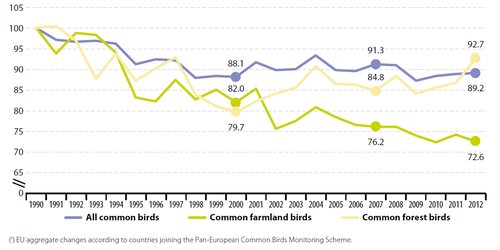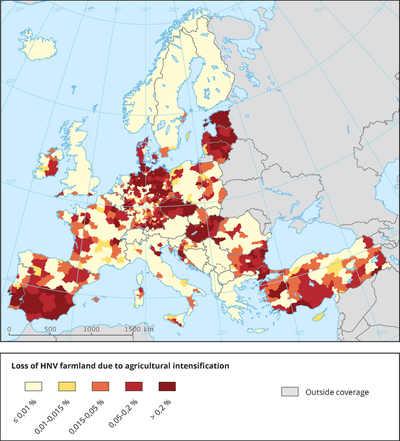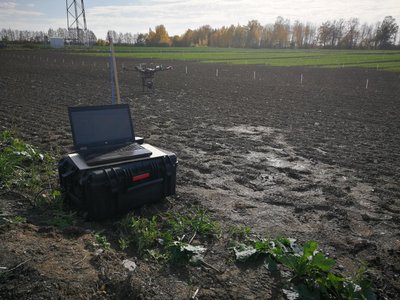The Food and Agricultural Organisation of the United Nations predicted that the global population will most likely reach 9.8 billion by 2050. This in turn needs food production to increase by 70% by that same year. These challenges come at a time where the first effects of global warming and biodiversity loss are being felt, especiallly in the field of agriculture. Agriculture and its practises have also come under increased scrutiny for the environmental damage they cause. 94% of Ammonia emmissions stemmed from agriculture in Europe in 2015, CO2 emmissions are considerable, as are methane emissions mainly stemming from enteric fermentation and the livestock industry. Nitrates in ground water, and the increased pressure on water resources, are two more ways in which agriculture ought to further mitigate its environmental impact.
Firstly it must be noted, that the detrimental effect of agriculture on the environment is only to the extent that food needs to be produced for consumers. But this is where it gets difficult: as consumers increase in numbers, the environmental detrement caused increases simultaneously. Add climate change in the mix, with some projections predicting yields in Southern Europe to drop by up to 50% by 2050, the future of food in the currently high-producing EU can seem bleak.
 Surrounding this, is a question of biodiversity loss worldwide, which ranges from the bird presence declining year after year (data courtesy of the FBI, the Farmlands Bird Index), to the soil biodiversity. This biodiversity on a microscopic level, not ony allows for soil fertility, keeping Europe’s agriculture alive, but also turns the soil in a very effective carbon sink, sequestring CO2 and helping to mitigate climate change.
Surrounding this, is a question of biodiversity loss worldwide, which ranges from the bird presence declining year after year (data courtesy of the FBI, the Farmlands Bird Index), to the soil biodiversity. This biodiversity on a microscopic level, not ony allows for soil fertility, keeping Europe’s agriculture alive, but also turns the soil in a very effective carbon sink, sequestring CO2 and helping to mitigate climate change.
Developments in modern farming technology
New developments are on the horizon, however. Modern farming techniques have implemented developments in the wider world, and applied them to farming. The modernisation of farming and pracital application of cutting-edge technologies has received a lot of attention and praise as a way to increase revenue and yield. Underlighted, however, is the environmental potential these technologies have. With yield per hectare going up, the intensification of farming can be kept at bay. Where pesticide use is saved on, biodiversity flourishes, and where grazing is monitored better, soil erosion can be prevented.
Digitised precision farming, of which IoF2020 is a flagship project and a great example, is relevant for environmental policy in two ways: on the one hand, precision farming is less intensive than traditional practices. This allows for a more environmentally conscious form of agriculture, while not giving in on profitability. On the other hand, the effects of precision farming, including increased yield, less water usage and less pesticide levels, can be of help in the adaptation of agriculture to a changing climate. With water becoming more and more scarce in Southern Europe, and soil protection being high on the agenda, developments in AgTech and IoT solutions should be a welcome ally in heading this challenge.
Environmental Protection under the EU Agricultural Policies
The flaghsip document relating to Europe’s farming landscape, is the Common Agricultural Policy (CAP). A previous article explained how the document works. Looking towards next year and the revision of the CAP, however, simplification and a stronger emphasis on the environment can further push the development of the digitalisation of the European agri-food sector.
The CAP is a powerful instrument in guiding farmers towards a more sustainable form of farming, but will (almost) only do so through economic incentives. Where the CAP provides the tools for action, it only refers to other (environmental) directives and policies in drawing up its priorities. Although this is the general way the CAP works, the influence it has through referring to other instruments cannot be underestimated.
The new CAP goes a step further by introducing ‘eco-schemes’, where more support is given to farmers voluntarily embracing more environmentally-conscious forms of agriculture. These schemes, however, are to be implemented by the member states. On the EU-level, mandatory requirements of farmers will already include more stringent rules, especially in relation to water and soil protection.
The Habitats Directive (HD) (92/43/EEC) sets out policies on the conservation of natural habitats and of wild flora and fauna. As agriculture takes up a vast portion of the EU’s land, much of which is important to maintain biodiverisity levels, it has quite the responsibility in protecting it. The Habitats Directive’s goals of protecting individual species through habitat protection, has to build on the original use of land, especially farmland. These areas of high natural value (HNV) are therefore characterised by low-intensity farming practices, and land management that is locally adapted. Both these aspects can benefit from the digitalisation of farming. The way in which the two Directives work together, shows the someitmes complicated relationship between the two. Conditionality of complying with some articles in the Habitats Directive are sometimes made in order to receive payments. These requirements can show the CAP to have quite stringent environmental goals, but often overlooked is that the addition of the link to the CAP payments, does not in any way add to the already binding obligations any farmer in Europe has relating to the Habitats Directive.
The relationship between the CAP and the HD, could therefore be regarded as windowdressing. However, the growing links between the two are a sign of recognition of the impact of agriculture on the environment. As environmental matters become more important in agricultural policy, the history of efficient reference between the two documents, show that great strides have already beent taken in aligning the two. The new CAP will focus on this aspect even more, and projects such as IoF2020 or SmartAgriHubs contribute to bridging environmental and agricultural interests.
A role for digitised farming in environmental policies.
Several IoF2020 use cases have proven such potential: Within-Field Management Zoning cases in North-West Europe have shown a 20% drop in soil fertility loss, while increasing crop yield by 5%. Data-driven Potato Production shows a 15% drop in pesticides used. The Grazing Cow Monitor use case has not only shown great potential in ammonia emmission reductions, but the technology can actually be used in tracking wildlife as well. The digitalisation of farming can take away the stress on intensively used farmland while improving yield. The role of such projects, is therefore not only restricted to interesting developments in agriculture, but creates new links between environmental policy, agricultural policy, and technology.
The new European Commission, and its greater focus on environmental and climate-related matters, and the new CAP, which tries to involve environmental consciousness into every aspect of agriculture, resemble the path the EU is embarking on. The new proposed CAP, shows not only that the divergence between agriclutural interests and environmental protection measures need to be overcome, but that they can be overcome.
Providing more tools to farmers to align these two challenges, however, is vital. Modern farming technology ought to be included in the package of options farmers can turn to. Digitalisation is broad, without doubt, and this can be a hurdle in making it a part of the CAP, or other Directives. However, the recognition of the importance of digitalisation in bridging environmental and agricultural challenges can lead to a greater implementation on the member state level.
As with the ‘eco-schemes’, the implementation of any potential ‘digi-scheme’ the CAP, will be for the member states to decide. This does not undermine the importance of handing this option to member states, however. Responding to those same needs, the overhaul of agricultural practices will create synergies between the three areas (agriculture, environment, and digitalisation), and ultimately lead to a more holistic and effective approach to the questions of flora, fauna, and future food.